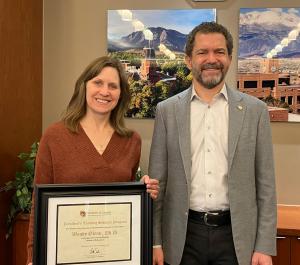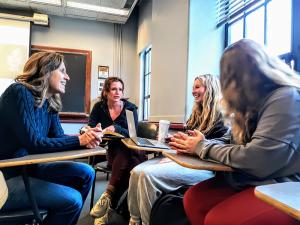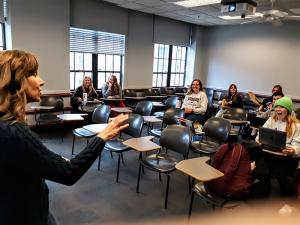Five questions for Wendy Glenn
Wendy Glenn, Ph.D., is professor of literacy studies and chair of the Secondary Humanities Teacher Licensure program in the School of Education at CU Boulder. Earlier this year she was named one of two new members of the President’s Teaching Scholars Program (PTSP), which recognizes CU faculty who skillfully integrate teaching and research at an exceptional level.
Her research centers on literature for young adults (readers ages 12-18) and how story can be used to both foster connection and invite disruption in students, teachers and the learning environments they share.
Glenn’s teaching is guided by the assumption that inviting classroom spaces and genuine student learning are predicated on the creation of a community in which each member feels valued, supported and capable.
As far as her free time, it isn’t surprising that Glenn says she’s always up for reading a book by the wood stove, by the campfire, by the ocean, wherever the opportunity arises. She also counts trying a new restaurant or recipe and enjoying live music in an outdoor venue as favorite activities. She and her husband recently entered the world of overnight backpacking, exploring less accessible parts of the wilderness.
“As someone who is happiest outside, I strive to spend time on the trails, in the tent or on the road as frequently as possible,” she said “My family enjoys visiting national and state parks to enjoy and learn more about these natural spaces. We feel deeply fortunate to live so close to Rocky Mountain National Park to the north and Eldorado Canyon State Park to the south.”
1. What did young adult literature mean to you as a young person growing up? Does it play the same role in the lives of young people growing up today?
As a young person, I remember feeling like I was in a perpetual state of moving – packing up our things, saying goodbye to friends made and then lost, wondering what the next new place would offer. Money was elusive, so we didn’t have much to pack, but my little collection of books, acquired as birthday and holiday gifts over the years, always found its way into a box labeled “Wendy.” So regardless of where I was, the characters I had grown to love in the stories I read were right there with me.
In many ways, books were home. They served as placeholders in my memories, the geographies of self that I carried with me across the years and across state lines.
I think young adult literature means different things to different readers in any time but would argue that story invites both connection and distance for every reader. As we read, we might see ourselves and our communities in the characters and settings described on the page. This might help us feel affirmed and less alone in the world. At the same time, we might see others and their communities in new ways as we are invited to imagine alternate ways of doing, thinking and being. This can invite empathy and open space for sometimes hard but always essential considerations of the dominant narratives that permeate our society.
2. When describing your approach to teaching, you have stressed the importance of creating a community. How do you go about making that happen?
Yes! My teaching is guided by the assumption that inviting classroom spaces and genuine student learning are predicated on the creation of a community in which each member feels valued, supported and capable. When students and teachers work together to build trusting relationships growing from knowledge of and respect for individual needs and interests, opportunities for authentic learning, growth and humanistic connection are fostered.
I learn about my students both with intention and from a place of genuine curiosity. In addition to asking them to share elements of themselves as both students in the classroom (How do you learn best? What makes it difficult for you to learn?) and in the world (What is your favorite way to spend a Sunday afternoon?), I design our course activities and assignments in ways that allow students to bring their full selves to the work, building in choice wherever possible and working to ensure that they are invited to engage with content through the lens of their individual lived experiences.
When we honor students as full people who hold intersectional identities (Crenshaw) and bring rich funds of knowledge (Gonzales, Moll and Amanti) into the space, they are more likely to open themselves to learning.
3. You taught junior high and high school students in the Mesa, Arizona, public school system from 1994 to 2001. What are your memories of that experience? Does it influence your university teaching?
I worked with pretty spectacular students. The schools in which I worked were comprehensive and large, with approximately 1,000 students in each grade level. Given my commitments to community, it was thus important for me to create a classroom environment where students felt supported as individuals in a sea of other people.
These students taught me that teaching is relational; it involves people who bring unique experiences, perspectives and passions into the classroom. Getting to know students as people allowed us to build and share in something powerful, something that enriched not only our learning about literature and writing but about ourselves and others.
I feel so fortunate to remain connected with several of these students, even now, 20 years after being their classroom teacher, and what they taught me in our experiences together in the classroom very much informs my work today with undergraduate and graduate students who aspire to be teachers themselves.
4. What does it mean to you to be named a President’s Teaching Scholar at CU?
I am proud and grateful to be a selected member of the President’s Teaching Scholar Program. As faculty dedicated to elevating the scholarship of teaching and learning across the CU system, the members of the group hold rich and varied knowledge around teaching and learning. I am excited to think more about collective attempts to share this expertise with others in our campus communities and to serve as resource people for advancing teaching and learning.
As university faculty, we might not always feel as though we hold the power necessary to enact change, particularly at the institutional level. As I learn more about the activities of the PTSP, it becomes increasingly clear that the program honors teaching as important university work and aims to both inform university leadership about issues concerning the current and future direction of university teaching and offer recommendations that matter for students.
5. What’s next for your research?
I am excited to pursue a new line of inquiry that explores social class and the representations of rural young people and their communities in young adult fiction. As a first dive into these ideas, I am examining the social narratives around environmentalism that offer particular positionings of people living in rural places. Rural people are depicted as farmers, deeply connected to the land, following the seasons in a beautiful cycle of sow, harvest and share. Or as ranchers who avoid attachment to the animals that they slaughter for profit. Or as small-town folk who abide by ultra-conservative politics and deny that climate change exists. My work seeks to unearth and complicate these competing and often contradictory narratives (and the fictional young people upon whom they are ascribed) by exploring how they appear (and don’t) in young adult titles featuring rural youth and centered on environmental content.





